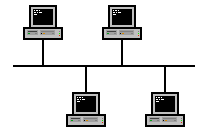Network Topology and Types Assignment Help
How Star, Bus, Ring & Mesh Topology Connect Computer Networks in Organizations
Network Topology
Network Topology is an arrangement of nodes, nodes are basically components of network. This arrangement define the network layout or the structure of the network in both the ways physically and logically which enable communication between components of network. Nodes are connected to each other in different ways that we are going to discuss further in types of network topologies and communication take place. Physical layout of topology define the layout of nodes, cables and workstations in the network whereas logical topology determine how the information flow and communication done between the components of the network .So now we are going to discuss the types of Network topologies and how they connect computer network in any organization.
Types of Network Topologies

Point-to-Point Topology
Point-to-Point is one of the simplest topology and basic model of conventional telephony that provide permanent link between two endpoints. The purpose of this topology is to establish communication between two endpoints. Example of this topology is children’s tin can telephone that associated with the two endpoints. This topology is easy to understand, use circuit-switching and packet-switching technology for the information flow and can be dropped when not needed by the user anymore.
Bus Topology
Bus is a type of network topology in which all the devices are connected to a main single cable called the bus. In other words we can say a line connected to devices in the network. From bus only all the devices are connected to each other and share resources and file. This network is simple to maintain because if one node fails to fail then rest can communicate with the others. Advantage of bus topology is easy to connect a computer to a linear bus which require less wired cable because a single cable wire is required. But one of the major disadvantage of this topology is once the main cable get fail then it will broke down the whole network. This network is easy to expand by adding additional nodes to the bus.
Network Topology and Types Assignment Help By Online Tutoring and Guided Sessions at AssignmentHelp.Net
Ring Topology
Ring is a type of network topology in which all the devices are connected in a closed loop and share data and resources to their adjacent nodes. Data can be shared with only two devices connected adjacent to a single node and flow of data has to be done in one followed direction only. Each node can receive data or can send data to the destination place. Basically this topology follow the token passing technology where each token contain data, sender and receiver information. Advantage of this topology is this is very organized and each node have equal access resource right. But the major drawback is if one device get fail it will break down the whole network.
Star Topology
Star is a type of network topology in which all the devices are connected to central hub through it communication take place between devices. A central hub can be a router or switch and all the devices are connected to central device with point-to-point connection. Central device act as a junction which manage and control all the data that pass from it before going to intended destination. Advantages of using this topology is easy to install such network. If one device is failed no need to disturb the whole network while remove that device from the network. Easy to detect faults and remove that part. But it also has some of the disadvantages like it require more cable as compared to linear bus topology and if central device fail then also disabled the attached nodes.
Tree Topology
Tree is a type of network topology that integrates the advantages of both bus and star topology. Basically it connect one star network with the another by the help of bus network and as many other star networks. Advantages of this technology is expansion is easy to add other devices, error detection and correction is easy, if one segment is damaged it doesn’t affect another device or segment. But this affect the maintenance of the network by adding additional nodes to the network and scalability depends on type of cable used.
Mesh Topology
Mesh is a type of topology in which each of the network node interconnected with one another and each node sends signal as well as relay data from other nodes. A true mesh is the one in which each node in the network connect to every node in the network which is also termed as full mesh or fully connected topology. But to establish such network is very expensive but still it is used in wireless networks. The techniques used by this network is Flooding or Routing. A device of network can transmit data to different devices at the same time. If one device get damage it doesn’t affect another device or sub-network in the same network. But cost is very high and set-up of this network is difficult to maintain, also network administration is difficult.


